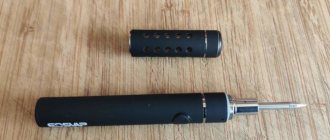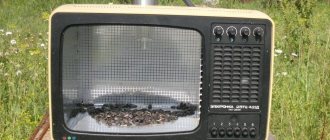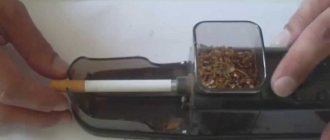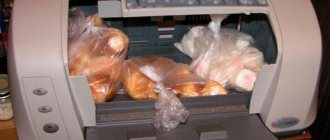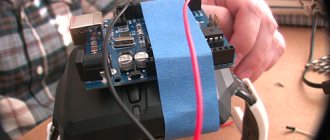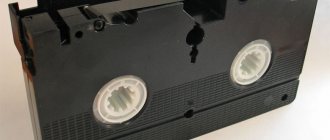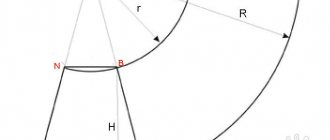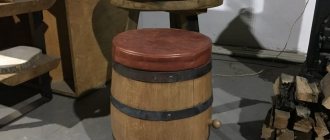Battery device
The battery is a simple, cheap and reliable source of energy for household appliances.
Battery design.
Inside such a device are:
- Positively and negatively charged poles.
- Catholyte.
- Mercury, nickel, lead, cadmium, nickel.
- Resin.
- Carbon rod.
The most important indicator of a power source is the charge capacity. It determines the price and operating period: the larger the capacity, the longer the battery will last.
Physics 5-8 grade
Experiments in physics at home for children in grades 5-8.
Magnetic motor
Experiment tools:
Progress of the experiment:
- Place the side of the battery where the minus is drawn on the magnet.
- If you have a wire spiral, do not connect its ends.
- The structure must balance.
- Using thin-nose pliers, make a dent in the battery.
- The wire structure is placed on the microbattery.
- At the top, the structure is located in a recess, not in contact with the magnet.
Analysis: The battery is a power source, a weighty base for the rotor. A magnet conducts electricity. The wire frame is a rotor with built-in brushes. Using a microbattery, particles are moved. Electricity, under a magnetic field, moves under the influence of the Ampere force.
The magnetic field is perpendicular to the current strength, which ensures the movement of the elements in a circle. The experiment demonstrates heat generation. As the motor runs for a period of time, the microbattery will begin to heat up.
Magnetic parachute
Required tools:
- cylindrical magnet;
- metal pipe.
- First, throw the magnet down without using the pipe.
- The magnet will fall to the floor.
- Pick up the magnet and throw it into the pipe again.
- Look into the pipe and watch the magnet fall.
Analysis: Magnet is associated with electricity. As the magnet moves, it can exert influence over the magnetic field, altering it. Circular currents are created due to the action of a magnetic field.
The current creates a magnetic field by interacting with a magnet. This causes the magnet flux to become smaller. The decline of the magnet is stopped by the magnet, which is attracted by the magnetic field.
Water candle
Experiment tools:
- candle;
- glass with liquid;
- smooth glass.
- Light a candle in a transparent glass filled with water.
- The candle does not go out.
Analysis: A candle and a glass are located on either side of the glass. The space between the glass and the candle should be level, which will allow the candle to burn in the glass. The glass displays a candle located at a distance from the glass equal to the distance from which the object is displayed. It looks like a burning candle under water.
Water Journey
Tools:
- glass of water;
- dye;
- ordinary napkins.
Progress of the experiment:
- Take glasses. Pour water into 3 of them and paint them with different colors.
- Take 2 more glasses. Leave them empty.
- Roll up the napkin, place part of it in one of the glasses with colored water, and place the rest of the napkin in one of the two empty glasses.
- Combine all glasses.
- The napkins will soon be saturated with water, and the glasses that are not filled with water will be filled. The liquid will be an intermediate color.
- The phenomenon will end when the water reaches the same level in all glasses.
Analysis: Colored water will rise through capillary channels using a tension surface, saturating the napkins. 2 empty glasses will fill with liquid due to the different location of the water. The pressure will equalize, the water level in all glasses will become the same - the movement of water will end. Homogeneous liquid in 5 glasses will be at the same level.
How to determine if the battery is charged
Many companies put a scale on the shell of their product that displays the amount of charge. When the light is red, it means the battery needs to be replaced.
Many companies put a charge scale on the shell of their product.
If there is no indicator, you can determine the amount of charge as follows: lift the battery 3-4 cm from the table (or other flat surface) and carefully release it. A discharged battery will bounce and fall, but a charged one will land smoothly.
For junior classes
Physics experiments at home for primary school children are presented below.
Soap bubbles in the cold
Materials for the experiment:
- bubble;
- plastic tube.
- Take the jar of soap bubbles out into the extreme cold, blowing out the bubbles with a plastic tube. Watch the bubble freeze.
- Beautiful patterns in the form of crystals will appear on the surface.
- When the bubble freezes, a dent will form, but the bubble will retain its spherical shape.
Analysis of the experiment: Negative temperatures freeze bubbles, since they are largely composed of water. The walls of the bladder become weak. The bubble cools. Crystallization begins. The shell of the soap bubble begins to sag at the top. The bubble dent increases.
Ball under water
Required:
- Throw the ball into the glass.
- Pour the liquid into it.
- Place the ball in the middle.
Analysis: When liquid is added to a glass, its surface becomes convex. And the tension distributed the ball in the glass in the center.
Balls and fire
Necessary materials:
Progress of the experiment:
- Inflate the balloon and tie it.
- Fill another ball with water and tie it.
- Light a candle and bring the inflated balloon to it, it will burst.
- Then bring a ball of water.
- After some time, traces of the candle will remain on the ball, but the ball will not burst.
Analysis: Until the liquid evaporates, the ball does not burst, because the water will take away the main amount of flame from the candle.
Extinguished candle. Fire
Experiment tools:
- candle, matches or lighter.
Progress of the experiment:
- Light the candle, then extinguish it.
- Bring the fire to the smoke that comes from the candle.
- The candle will light again.
Analysis of the experiment: Smoke rises from a candle because it contains paraffin that ignites. The paraffin reaches the wick and the candle lights up again.
Paraffin motor
Experiment tools:
- Place a toothpick on the candle in the center - this will become the axis of the engine.
- Having balanced the structure, place the candle between two glasses.
- Light the wicks on both sides.
- The structure will gradually begin to swing in different directions.
Analysis of the experiment: The weight of one end will become greater than the other, which will lead to the movement of one of the ends under the influence of gravity. The pulsation occurs due to a change in the weight of the ends of the candle. The pulsation increases as the flame burns more and more.
Cutting wood using a paper disc
Required tools:
- Remove the disc from the grinder. Place the disk on paper and trace its contours.
- Make a similar object on paper. Attach it to the grinder by turning it on. Bring a match and cut.
Disposal rules
Many packages indicate that batteries should not be thrown away - only recycled. There are enough harmful compounds inside the battery to cause irreparable damage to soil, water and air. The contents of food sources are also toxic for our health, so we must follow the rules for their disposal.
In some areas of the country it is difficult to find special collection points for waste energy sources.
In this case, proceed as follows:
- Agree with friends and family that you or someone else will be responsible for collecting and disposing of dead batteries.
- Find collection points in your nearest locality. Every large city has at least one battery collection point. Most often they are located next to hardware or furniture stores.
- If you live in a populated area far from the metropolis, you can negotiate with the local Ministry of Emergency Situations or representatives of factories that recycle batteries.
Never leave old batteries in the public domain. Store them in plastic boxes until disposal. Don't forget: Toxins seep into the air you and your loved ones breathe.
Examples for preschoolers
Physics experiments at home for preschool children.
Magnetic pencil
Required materials for the experiment:
- Battery.
- Thick pencil.
- Wire. Diameter from 0.2 to 0.5 mm.
- Insulating tape.
A magnetic pencil is a spectacular physics experiment that can be easily done at home
. Experiment progress:
- Wrap the wire near the pencil, leaving a distance to the edge of 0.5 - 1 cm.
- At the end of one row, wind the second row in the opposite direction. Until the wire is completely wound. The main thing is to stock up on two ends of wire about 8 cm long. Secure the turns with tape so that they do not unwind.
- Clean the remaining 2 ends of the wire, connecting to the battery.
Result of the experiment: during a physics experiment at home, it was possible to make a magnet capable of attaching small iron objects.
Top
The top is in a vertical position during rotation of the circulation around the axis, and falls as the rotation slows down. During the movement of a multi-colored top, visual elements of color mixing and elements of color dispersion are observed.
Color Experience:
- An ordinary top model is sectors. The circle is divided into the corresponding number and painted in different colors.
- During rotation, a color change is observed.
- The experiment demonstrates the combination of colors. Experiments are carried out with sectors.
When dividing the top into 7 sectors, decorating the sectors depending on the location of the color, during rotation the top will change color, becoming white. The experience that takes place is the mixing of colors. In some cases, the effect is not achieved, but a multi-colored shade is created.
Magic top
Materials and course of the experiment:
- Print templates in black and white colors, make 2 tops from the materials.
- When the first top spins, rings of different colors will appear.
- When rotated in one direction and then in the other, the rings will be different from each other.
- The second top becomes like a circle.
| Analysis | Data |
|
|
lemon battery
The battery is easily created from fruits. The voltage depends on the fruit. The benefit of lemon is citric acid, which is capable of creating an electric current.
Required tools:
- Lemon.
- Wire (copper). The larger the experiment, the more wire you will need. If you don't have one, you'll need a coin.
- Zinc plate. A bolt, screws, and wire are used as a plate.
- Multimeter (measures voltage).
- Light-emitting diode. (Fixes the current).
Precautionary measures
Do not dispose of it yourself. Do not burn or bury batteries, no matter how many. According to the latest data, one old battery harms the territory that can be inhabited by a hedgehog, 2 trees and a thousand worms.
Do not store batteries in metal boxes. The contents cause metal corrosion and seep into the soil and groundwater.
Failure to recycle causes irreparable damage to the environment and public health. Recycling old batteries is an event organized solely for the purpose of preserving the environment.
DIY light bulb
Discharged batteries are also used for small light bulbs inserted into crafts.
For this purpose, it is better to take lamps with low power so that the remaining charge in the battery is enough to emit light.
A discharged battery makes a loud sound when dropped from a height of three centimeters.
You will need:
- discharged battery;
- bulb;
- adhesive tape;
- plasticine;
- copper wire;
The copper wire is divided into 2 parts, one part is tied to the pole with a negative charge with adhesive tape. The second part is screwed onto the light bulb base. The end of the wire on the lamp is connected to a terminal with a positive charge. The glow will appear when the circuit is closed.
The light is bright, it is used as a flashlight or a small night light in a dollhouse.
Explanation of experience
Surprisingly, the mechanism for the formation of a whirlpool is the same - in the ocean, in a bathtub, and even when giant cyclones arise. A fast flow of water (air) collides with an obstacle (shore, stone, oncoming flow) and rushes back. But there he stumbles upon himself, and moves forward again! The water flow has no choice but to move in a circle, accelerating under the influence of centrifugal force. Water moving quickly in a circle tends to the edge of the funnel, and in the middle a depression is formed, an area of low pressure, into which any object that happens to be nearby is drawn.
“The mechanism of the occurrence of sinkholes with younger schoolchildren can be continued to be studied in the summer at the dacha. For example, direct water from a garden hose into the side of a filled children's pool. Having encountered an obstacle, the flow of water will begin to swirl into a funnel.
Older students will be interested in learning about the Coriolis force - it takes into account the influence of the earth's rotation on global geophysical processes. Under its influence, cyclones in the Northern Hemisphere of our planet always spin counterclockwise, and in the Southern Hemisphere - clockwise. There is an opinion that this effect is noticeable not only on huge air masses, but even in the drain holes of our sinks - supposedly in the Northern Hemisphere, the water in the drain hole always spins counterclockwise, and in the Southern Hemisphere - vice versa, and by this sign you can even determine when a man on a ship crosses the equator! You can experiment with your child at home - it's a lot of fun. But, of course, in practice this effect is completely invisible; too many factors in our bathtub and sink are stronger than the Coriolis force - from surface unevenness to the symmetry of the location of the drain hole. Although, who knows, maybe you have the perfect sink at home?
Reply to the post “The Beauty of Water”
In April I made a series of similar videos.
At first I filmed with the phone covered with regular glass, because I was afraid of messing it up, so there would be glare on some videos.
Well, a chicken egg.
Then I got tired of washing the glass after each shot, wiping it down so that there were fewer streaks, and the glare was also annoying, so I decided to continue shooting without it.
Two balloons, no water. I'm not good at physics, so I don't know why this effect happened. (watch from 18 seconds)
Coca-Cola (from 11 seconds)
And finally, the most colorful part. Balloons with water to which I added regular food coloring (the one used to color Easter eggs)
Shot in automatic mode.
The green one, compared to the yellow one, did not collapse immediately, but only after the second bullet hit.
Well, red with the blood of babies
I filmed, as everyone has already seen, on a Huawei P40 Pro.
Huawei AF15 tripod-ponopod.
Pistol Gletcher TAR92
Shooting mode, super slow motion video x256 or 7680 fps.
Mobile hand warmer
An indispensable thing in frosty weather, when your hands freeze in a few minutes, and gloves and mittens do not warm at all.
This mini-heater can be easily constructed from a battery and wrapping paper or foil. The power supply is wrapped in foil and its ends are connected to two terminals. The heat is well retained under the wrapper and will provide comfort to cold extremities.
What can be done from old towels and practical ideas for saving
Before carrying out manipulations, charge the batteries.
The Great Mystery of Water
I don’t know about you, but as a child I wanted to repeat an experiment from one pseudoscientific film - the great mystery of water. The meaning is this: if you plant grass and say good words to it, then it will grow better, but if it swears in another pot in which the same seeds are sown, then nothing will grow there.
In general, I planted grass. Everything would be fine, but I did not take into account how the experiment looked like the following side.
I lived on the first floor, it was summer, the windows were open, and under the window there were grandmothers who were driving.
In general, all week I shouted obscenities at the unfortunate jar of weed oats, the procedure lasted about 10 minutes.
As a result, the grandmothers gave up first and went to another yard.
Result 2 - it grows the same way, it makes no difference what words you say. So there is nothing to please the farmers.
Preparatory work
10 best examples of renovation of old houses: “before” and “after”
To properly prepare the light bulb for use, you need to stock up on:
- bulb
- pliers
- screwdriver
- thick rubber gloves
- sheets of paper
Cover the work surface with paper, this will prevent further searches for small fragments. Even though the light bulbs are made of very thin glass, there is still a risk of cutting. Therefore, it would be a good idea to wear gloves. Next, remove the contact from the lamp base using pliers. Using a screwdriver, we break it and pull out the base insulator; we do this very carefully so as not to damage the light bulb and ourselves. After which you can use tweezers or small tongs to remove the entire contents of the light bulb out. The final step is to clean the inside surface of the glass with a dry cloth.
The main reasons for battery failure
Most likely, every motorist is familiar with the design of the battery. But, nevertheless, we will briefly refresh this knowledge.
A battery is a device that, on the one hand, converts the energy obtained as a result of a chemical reaction into electric current, and on the other hand, is capable of collecting (accumulating) the electric current produced by the car's generator. To ensure these processes, the battery contains two sets of lead plates with positive and negative charges, and an alkaline solution, which serves as the so-called electrolyte. These are actually all the components of such a complex device at first glance. So what problems can happen to it?
- Destruction of plates. The reasons for this may be factors such as the use of an electrolyte that is not suitable for climatic conditions, “overcharging” of the battery, a long discharged state, mechanical damage due to poor fastening of the battery.
- Short circuit. The reasons in this case are the destruction of the separators or the formation of growths between the plates.
- Sulfation. Perhaps the most unpleasant problem possible. Occurs when a discharged battery is stored for a long time or there is a lack of electrolyte during operation.
- Electrolyte contamination. A common “disease” of the batteries being discussed. It arises quite simply and is just as easy to fix with your own hands.
- Intensive self-discharge. One of the most common malfunctions. There can be many reasons for this – from a poorly tensioned alternator belt to a low level of acid in the battery.
- Reversing the polarity of batteries. The cause of this problem may be incorrect and prolonged switching on of the battery. Eliminated by several discharge-charge cycles.
So, having dealt with the main “diseases”, it’s time to talk about how to cure them. Simply put, let's move on to practical recommendations that will help you update a battery that has become unusable.
Animals and insects made from resistors and transistors
To be honest, it is not always possible to guess which animal or insect appears before us in the form of radio components. However, quite a few of them have been invented, and the talented modeling of the figures of all kinds of animals often amazes the imagination.
In any case, this spider is a very plausible tarantula. Its manufacture will require hundreds of electrolytic capacitors and a lot of time.
Perhaps it's a swimming bug, let the experts decide. Its wings are made from two parts of identical printed circuit boards.
Dragonfly is just a strategic bomber! For the craft you will need a whole set of printed circuit boards and dozens of operational amplifiers.
The most ambitious craft is a sea turtle. It’s better not to take on this, it will obviously require several performers.
Now let's look at crafts that are more realistic to repeat, increasingly simpler. The crocodile is very recognizable, isn’t it made of microcircuits in nature?
It is normal that crayfish have different claws. It so happens that he loses one of them during “sea battles”, and another begins to grow in its place...
Regardless of color, I don’t like cockroaches either. However, these individuals have two positive characteristics: they do not cause harm and soldering such insects is not at all difficult. If you make a lot of them, it will be very realistic.
Awesome spider! The craft is not complicated, but where can you get exactly these components?
Adorable mouse and not difficult to replicate. I wonder if this is an active hero for children?
There are quite a few different dogs on the Internet, but I liked this one the most: minimal details and very expressive! Please note that a glue gun was used for installation.
Little tricks
- Small half-liter bottles are easier to manipulate, and larger ones produce more spectacular swirls.
- The water can be colored a little. And even add glitter to it!
- If you want your child to also get practical benefits from your activities, tell him how to behave on a river or in the sea if he gets caught in a whirlpool. The strength of the whirlpool weakens at depth, so swimmers who feel like they are being pulled into a funnel are advised not to waste energy fighting the current, but to allow it to pull them in. Having dived into the funnel, you need to make several strong strokes underwater and then, most likely, you will be able to emerge far from the danger zone. But the best thing, of course, is never to get into such a situation!
Good luck with your experiments! To be continued.
If you conduct experiments at home yourself, write to us, send photos and videos of your experiments. Let's put together a home laboratory workshop!
Source
Hydrochloric acid filling method
Batteries can be revived by opening their casing. The method involves complex steps, but in general they are safe. Make 2 holes near the carbon rods. 10% hydrochloric acid is drawn into a syringe and the composition is injected into the battery. Acid can be replaced with high-percentage vinegar. Let it sit for several hours and close the holes with a suitable material: auto sealant, plasticine, wax will do.
Such methods of resuscitation do not always work, but for the most part they still give a positive result. You just need to remember that a restored battery comes back to life only for a short time, but this should be enough to find a replacement for it.
Reply to the post "Egg"
I did everything according to the canon. The egg was half covered with toothpaste. And also the “without protection” part. And yes, I remembered my childhood, thanks to the post of the first experimenter.
First minutes. Bubble Formation
The liquid begins to foam
The egg became unusually soft, but not the part where the toothpaste was
6 hours later the shell part was like wet paper, the toothpaste part was still hard
Conclusion: toothpaste can protect eggshells from 10 percent vinegar for at least 4 hours. The further process of destruction occurs, it just takes time. Thanks to all. Conclusion: the total lockdown has a very detrimental effect on my psyche. I haven’t smoked for 8 days, I’m spoiling food, I’m creating replies to the post)) Have a nice evening, everyone.
